"See the tag? Hanging down. Yes. Park by that." The parking attendant points at the far wall.
"Um. That sign on the wall? There?"
"No. The tag. See that tag hanging there?" I glance over in the direction he's pointing, desperation creasing the ridge of my brow…. There's nothing. "Yes, that tag. Park by that."
"Oh okay. Thanks." I park in the general direction he was pointing and hope for the best.
I'm in a parking garage in downtown Cleveland, and I'm on a quest. Since the arrival of the pandemic I've been shooting black and white film. Being confronted by the fact that in such a short period of time my whole world changed and slipped away made me want to record it. Save some memory of what was lost.
Up until now I've been shipping out my film to be processed and returned. It's not cheap and it's getting to the point where I'm shooting less because I don't want to have to keep paying for it.
For a while now I've known about the Cleveland Print Room. They have open darkroom hours. I have a degree in photography and don't want to keep paying someone to process my film. I also have kids, a creative career, house repairs, laundry, meals to make. I've been planning on checking out the darkroom for four year's worth of "next weeks".
Today is the day.
Up the elevator, through a room of college students having a critique (Pardon me young people, elder millennial coming through.), and into the darkroom.
Well, not quite. Darkrooms generally have two parts. One part where you develop film and one part where you make the prints. I'm standing in the well lit film developing area. I get a tour. There is a large sink and lots of tanks and graduated cylinders.
The darkroom attendant gives me a quick run down of where the chemistry is, what temperature to use it at, and at what dilution. I'm staring at her and nodding confidently as the numbers she tosses at me bounce off my head like bugs on a windshield.
"Do you remember how to load film on a reel?" she asks. "It's like riding a bike."
I take some proffered test film and a reel, without looking at what I'm doing (with real film this has to be done in complete darkness.) I feel for the entry notches on the reel, slide the film into them, start ratcheting the reel back and forth, and the film is taken up with no snags.
I realize later this was probably a test on her part.
Having passed the test I get led back into the darkroom itself. A quick survey of the equipment. Things are pointed out to me, its dark, that I'm can only imagine, as its dark. Then I'm left to my own devices.
Loading film onto a reel is a compromising situation. You have to go into a little room and turn off all the lights. Once your film is out of the little canister you can't turn on the lights again until the film is on the reel and secured away in a developing tank. This is fine if everything goes as planned. Less so if you put the lid of the tank somewhere you can't find while groping around in the dark.
There is also a level of performance anxiety. You are in this little room. Everyone outside of that little room knows what you are doing in there. If you're in there too long everyone knows that something is going wrong in there. It's somewhere between using a bathroom stall at a busy airport and trying on clothes in a fitting room with an overzealous sales person.
Knock knock. "How's it going in there?"
The first reel loads like a charm. The second snags, is unwound, snags again, is cut to round off the corners (in the dark, by feel), and then smoothly transitions onto the reel.
I emerge from the little room with all the confidence and awkwardness of a twelve year old boy who just picked out his first pair of jeans at the Gap. Not too snug in the crotch. Equal parts swagger and cringe.
From there my experience begins to reassert itself. Temperatures are checked. Chemistry poured in.
When developing film you have to agitate the tank its in every thirty seconds or so. To keep fresh chemistry moving along the film. You can't shake the tank too much or you risk making bubbles that will settle on the film and ruin it. So there is a rolling of the wrist that turns the tank around. Then I tap it against the side of the sink to dislodge any wayward air pockets. I set the tank down and wait twenty five seconds to repeat it. For eight minutes I give this my undivided attention.
I love it. The very act is meditative. The tap tap. The rolling of the tank. The smell of stop bath is bilious and sharp. It's unpleasant to anyone who's never lost an afternoon to the dim red lights of a darkroom. To me it smells like being sixteen and doing something that feels almost occult in my high school darkroom. It smells of being twenty one, at college, and having the whole world before me. It smells of being thirty, making do in a makeshift darkroom, knowing that this wasn't going to be the life I thought it was, but doing it anyway, as a place to shelter in while life raged on outside in the light.
And now. It's smells of being forty two, finding my way back to it, developing pictures of my children that sixteen year old me never thought I'd have.
About twenty minutes later the rolling and tapping has ceased. I remove my now developed film from the wash, hold it up to the light, and laid out before me is my whole story.
My children, my neighborhood, campaign signs, the cello concert my neighbors put on in their yard, the small memories that slip so quietly through our lives, seen through the eyes of all the years that brought me here. Sixteen. Twenty one. Thirty. Forty two. Forever burned in grains of silver by the light that made them.
It's magic. It really is.
Once my film is dry I safely pack it up. I thank the darkroom attendant for her time and tell her I'll be back again soon.
My car is where I left it. No tickets. I still can't find the hanging tag, but it's fine.
I get home and show my kids these pictures I made of them year's ago. I can't tell if they are humoring me. Soon their interest is lost in stories about their day. Then dinner and a bath.
That night I go to sleep with the smell of stop bath just barely a whisper in the air around me as I fall asleep.




































































